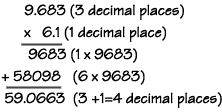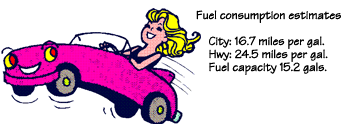MULTIPLYING DECIMALS
Definition
Multiply the numbers just as if they were whole numbers. Line up the numbers on the right - do not align the decimal points. Starting on the right, multiply each digit in the top number by each digit in the bottom number, just as with whole numbers.
Concept Meaning
Find the product of 9.683 x 6.1=?

- Line up the numbers on the right,
- multiply each digit in the top number by each digit in the bottom number (like whole numbers),
- add the products,
- and mark off decimal places equal to the sum of the decimal places in the numbers being multiplied.
Try this word problem. You'll use your estimating skills as well as your multiplying skills.

Jackie just bought a new car. Use the information in the picture to find out how far she will get on the highway before she runs out of gas and has to call a tow truck.
Estimate to the tens place24.5 rounds to 20, 15.2 rounds to 20
20 x 20 = 400 miles
Now multiply the original numbers to find the exact answer.
24.5 X 15.2 = 372.40
Teaching Resources
There's a bit of a silly trick to multiplying decimals. It's not really a trick -- it's just how it works -- but, it's so weird that it may seem like a trick.
It's going to sound confusing at first. Just read through it, then look at the examples, then read it again. It'll be really easy!
Here's the deal:
| 1) | Ignore the decimal points and multiply as usual... |
| 2) | Count how many total digits are on the right side of the decimal points in the guys you are multiplying... |
| 3) | Place the decimal point in your answer so there are this many digits to the right. |

And remember, you can always grab a calculator to check your answers on these!
Here's an easy to follow lesson plan
Objective: By the end of the teaching segment, the students will be able to multiply decimals, and apply this concept to word problems.
Resources:
For this lesson the students will only need a pencil. The problems will be given from the teacher for the students to work through.
Procedure:
I. Multiplying Decimals
A. The students will be given the problem:
3.05 x 4.36
B. The teacher will explain that they must first write the problem in a vertical fashion.
3.05
x 4.36
C. The next step is to simply ignore the decimals and multiply this problem like a normal multiplication problem.
Ans: Without decimal places 132980
D. Now the student must go back to the original problem and count the number of decimal places each number has. (e.g. how many numbers are to the right of the decimal point?)
E. The student will be asked to add the number of decimal places from both original numbers.
Ans: 4
F. The student will then place the decimal point of the answer 4 decimal places into the number.
Ans: 13.2980
II. Application To Word Problems
A. The student will be given the following problem:
Suppose a phone company charges $0.53 for the first minute and $0.27 for each additional minute for a long-distance call. How much will a 15 minute long-distance call cost?
B. The teacher will explain that we must first realize that the first minute will cost $0.53. This will be used later when we add the total cost of the phone call.
C. The students will then create a problem for the remaining minutes. How much does each of these minutes cost? Ans: $0.27
0.27
x 14
D. So, the teacher will ask the students to solve the problem using the method of multiplying decimals discussed earlier.
0.27
x 14
$ 3.78
E. The teacher will point out that this is just the cost for 14 minutes. The phone call made lasted 15 minutes. The teacher will ask what the students need to do next.
Ans: 3.78 + .53 = 4.31
F. The students will be asked to write a "therefore statement" stating their results.
Ans: Therefore the 15-minute long-distance phone call will cost $4.31 .
Assessment:
At the end of the teaching segment, were the students able to multiply decimals correctly? Were they able to apply this to common story problems?
A simple worksheet for students to practice
| Thomas earns $3.00 per hour working. If he works for 2 hours, how much money will Thomas earn? | |
| Rebecca has $21.00. Cards cost $3.00 each. How many cards can Rebecca buy? | |
| Beverly spends $24.00 on cards. Each card costs $6.00. How many cards did Beverly buy? | |
| Shawn worked to earn $35.00. If he worked for 5 hours, how much money does Shawn earn per hour? | |
| Kathleen has $16.00. Eggs cost $8.00 each. How many eggs can Kathleen buy? |
Documentaiton of Sources
Definition: www.math.com/school/subject1/lessons/S1U1L5GL.html
Multiplying Decimals: http://www.math.com/school/subject1/lessons/S1U1L5EX.html
Video: http://youtu.be/JEHejQphIYc
Lesson plan: http://mste.illinois.edu/courses/ci399TSMsu03/folders/jmpeter1/Teaching%20Lessons/Lesson%20Plan%201%20-%20Decimals(CI399).html
Common Core Standards
5.OA.7: Add, subtract, multiply, and divide decimals to hundredths, using concrete models or drawings and strategies based on place value, properties of operations, and/or the relationship between addition and subtraction; relate the strategy to a written method and explain the reasoning used.

No comments:
Post a Comment